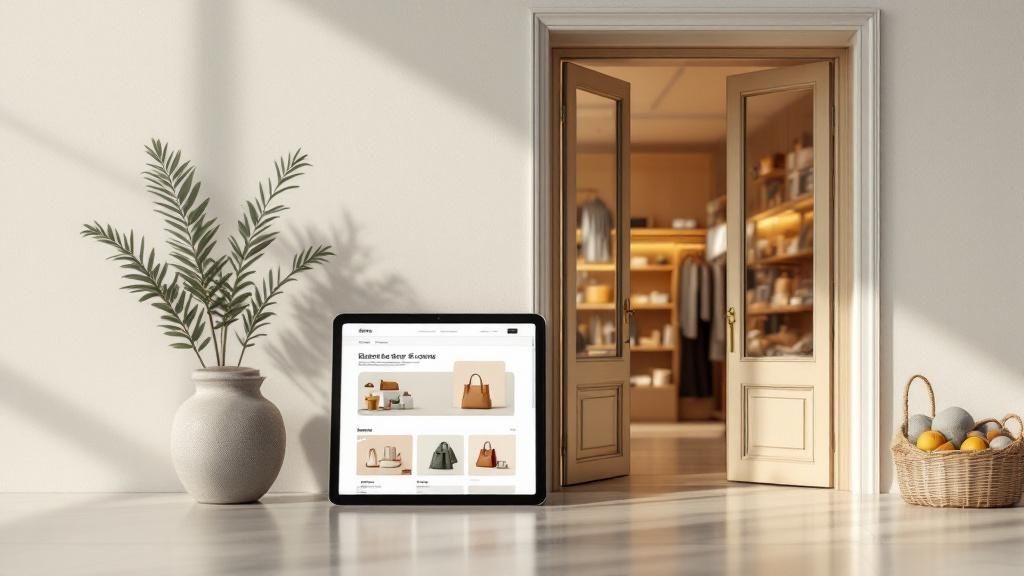A multichannel sales strategy is all about meeting your customers where they already are. Instead of trying to funnel everyone to a single point of sale, you set up shop across multiple, separate platforms.
Think of it as setting up a series of specialized storefronts. You might have one on a busy main street (your physical store), another in a massive digital mall (like Amazon), and a third that reaches people directly through their mailboxes. Each one operates on its own, optimized to do its best in its specific environment. The main goal is to get as much visibility and as many sales as possible within each of these channels.
What Exactly Is a Multichannel Sales Strategy
Picture a talented musician trying to grow their audience. They wouldn't just play in giant stadiums. They’d also play local festivals, get their music on Spotify, sell t-shirts on their own website, and post behind-the-scenes clips on social media. Every single one of those "venues" is a distinct channel, and the musician’s approach is tweaked to fit the crowd at each one.
That’s the essence of a multichannel sales strategy. It’s about being present and active wherever your potential customers might be when they realize they need a solution like yours.
The Channel-First Approach
This is different from an omnichannel approach, which focuses on weaving every channel into a single, seamless customer journey. A multichannel strategy treats each platform as its own independent opportunity. The emphasis is squarely on maximizing performance within that specific channel.
For instance, a business using this approach might run:
- A 20% off sale exclusively on their e-commerce website to boost online traffic.
- A "buy one, get one free" deal in their physical stores to get more people through the door.
- A targeted lead generation campaign on LinkedIn aimed at specific professional roles.
- A unique product line sold only through a marketplace like Amazon or Etsy.
Each channel has its own goals, its own promotions, and its own way of measuring success. They operate in parallel, casting the widest net possible to catch sales from different types of customers. They don't have to be perfectly in sync.
The core idea is simple: don't force customers to come to you; go to them. By setting up a presence on multiple platforms, you create more paths for people to discover and buy what you're selling, which dramatically expands your reach.
Why This Strategy Is Gaining Traction
It’s becoming impossible to ignore how well this works. Fresh data shows that 86% of marketers see multichannel strategies as increasingly effective, which points to a huge shift in how businesses are thinking about connecting with their audiences.
Unlike omnichannel, which requires complex and deep integration, a multichannel sales strategy lets you be more nimble. You can run targeted tactics on each platform—like a special offer for your website that's different from a direct mail promotion—without overhauling your entire system. To dig deeper, you can explore more about these multichannel marketing trends and their impact on sales. This adaptability makes it a powerful way to widen your reach and engage a diverse customer base without the headache of building a perfectly unified system right away.
The Real-World Benefits of Selling Across Multiple Channels

Putting a multichannel sales strategy into practice isn't just about ticking boxes on a marketing checklist. It’s about building a stronger, more resilient business from the ground up. When you move beyond the theory, you start seeing real, measurable results that drive growth and solidify your place in the market. The most immediate impact? A much bigger customer base.
Think about it: by showing up on different platforms, you connect with people who have completely different shopping habits. A buyer who finds you through an Instagram ad might never set foot in your physical store. At the same time, someone who discovers your product on a huge marketplace like Amazon might have never stumbled upon your direct e-commerce site. Every channel you add is like casting a new net in a different part of the ocean—you’ll catch customers you would have otherwise missed entirely.
Amplify Brand Visibility and Reach
A multichannel approach essentially puts your brand on billboards all over the digital and physical world. Each channel you're active on—whether it's your social media feed, your website, or your storefront—works to make your brand more recognizable. This creates a powerful snowball effect, keeping your business top-of-mind.
Let's imagine a local artisan who sells handmade goods. If they only have a brick-and-mortar shop, they're limited to whoever walks by. But look what happens when they add just two more channels:
- An Etsy Store: Suddenly, their products are available to a national, or even global, audience that is specifically looking for unique, handcrafted items.
- Instagram Shopping: This lets them showcase their work visually, engaging a community of followers and turning casual scrollers into paying customers right from their phones.
This isn't just about adding a couple of new ways to make money. It’s about cementing the artisan's brand in the minds of a much, much larger audience.
Diversify Revenue and Build Resilience
Putting all your eggs in one basket is a risky business strategy. What happens if your single sales channel—say, your physical store—gets hit by a local economic downturn? Or what if your main online marketplace tweaks its algorithm and your product visibility tanks overnight? A multichannel strategy is your safety net against this kind of volatility.
By diversifying how and where you sell, you build a far more stable and robust business. When one channel has a slow month, the others can pick up the slack, evening out your revenue and protecting your bottom line from market surprises.
The numbers back this up. Marketers who use three or more channels in their campaigns see an order rate that is nearly five times higher than those who stick to a single channel. This approach doesn't just attract new customers; it keeps them. Companies with strong multichannel engagement report significantly better customer retention and higher lifetime value.
On top of that, this strategy gives you a goldmine of data. By comparing how each channel performs, you gain incredible insights into what your customers want, helping you make smarter choices about everything from inventory to marketing. This is just as critical for B2B companies, too. If you're interested in sourcing clients from various platforms, our guide on B2B sales lead generation is a great place to start. In the end, selling across multiple channels is one of the smartest things you can do to secure your company's long-term growth and stability.
Core Components of a Winning Multichannel Strategy
A powerful multichannel sales strategy doesn't just happen. It's built piece by piece, with smart choices and consistent follow-through. Think of it like building a high-performance engine; you need the right parts, they have to be top-quality, and they must all work together to generate power. In the same way, your sales strategy relies on a few core components to generate revenue.
At its heart, this approach is all about making deliberate decisions about where you sell, what you say, and how you measure success. The three pillars of a winning strategy are intelligent channel selection, consistent brand messaging, and data-driven optimization. Getting these right is what turns a scattered sales presence into a coordinated and highly effective force.
The infographic below breaks down how these core functions—understanding your customer, integrating channels, and using analytics—form the foundation of a cohesive strategy.

As you can see, it all starts with knowing your customer. That knowledge dictates your channel choices, and everything is constantly fine-tuned with analytics.
Choosing the Right Battlegrounds
First things first, you have to pick the right sales channels. This isn't about being everywhere at once; it's about being exactly where your ideal customers are most likely to shop and buy. Spreading your resources too thin across a dozen platforms is a recipe for mediocrity. You’ll see much better results by dominating just two or three highly relevant ones.
So, how do you choose? It starts with deeply understanding your audience. Where do they hang out online? Which marketplaces do they already trust? Are they more open to a direct email, or do they prefer discovering products on social media?
Here are a few questions to ask when you’re sizing up a potential channel:
- Audience Alignment: Is my target demographic actually active on this platform?
- Resource Cost: What will it cost us—in time, money, and people—to really succeed here?
- Sales Potential: Does this channel have a history of working well for products or services like ours?
Answering these honestly will stop you from wasting time and money on channels that were never going to deliver a solid return.
Comparing Potential Sales Channels for Your Business
To help you get started, this table outlines some common sales channels. Use it to compare where your business might fit best based on who you're trying to reach and what resources you have available.
| Sales Channel | Target Audience | Setup Cost & Effort | Strengths | Challenges |
|---|---|---|---|---|
| Direct Mail | Older demographics, B2B decision-makers, local customers | Moderate to High | Highly targeted, tangible, low digital noise | High cost per impression, hard to track ROI |
| Email Marketing | Existing customers, warm leads, B2B professionals | Low | High ROI, personal, great for nurturing leads | Can get lost in inbox clutter, requires a good list |
| Social Media (e.g., Instagram, Facebook) | B2C, younger demographics, brand-aware consumers | Low to Moderate | Massive reach, great for brand building, direct selling features | "Pay to play" environment, requires constant content |
| Online Marketplaces (e.g., Amazon, Etsy) | Price-sensitive shoppers, product-focused buyers | Low to Moderate | Built-in traffic, trusted platform, easy setup | High competition, platform fees, little brand control |
| Your Own E-commerce Website | Brand loyalists, customers seeking a direct relationship | Moderate to High | Full control over branding and customer experience | Requires generating your own traffic, high maintenance |
| Cold Calling / Outbound Sales | B2B, high-value enterprise clients | High | Highly personal, immediate feedback, good for complex sales | Low success rate, resource-intensive, often disliked |
Remember, this is just a starting point. The best mix of channels is unique to your business, your product, and most importantly, your customer.
Maintaining a Unified Brand Voice
Once you've picked your channels, the next challenge is to sound like the same company everywhere. Your tone might shift slightly—for instance, you'll probably sound more professional on LinkedIn than you would on Instagram—but your core brand identity has to stay solid.
Your company's values, visual look (logos, colors), and the promise you make to your customers should be instantly recognizable, no matter where they find you. This consistency is what builds trust and makes your brand memorable.
A customer should feel like they are interacting with the same company, whether they're on your website, reading an email, or seeing an ad on social media. This cohesiveness is the glue that holds your multichannel sales strategy together.
Inconsistent messaging will only confuse people and weaken your brand. Imagine a company that positions itself as a premium, luxury brand on its website but bombards Facebook with aggressive, discount-focused ads. That disconnect creates distrust and cheapens the perceived value of what they sell. The trick is to adapt your delivery without changing your core message.
Using Data to Steer the Ship
The final—and arguably most critical—piece of the puzzle is a commitment to data. You simply cannot know what’s working unless you measure it. A successful multichannel strategy is a living thing, constantly being tweaked and improved based on real performance metrics.
You need a solid system for tracking Key Performance Indicators (KPIs) across every single channel. This is how you answer the make-or-break questions:
- Which channel is bringing in the most leads?
- Which platform has the best conversion rate?
- What’s our customer acquisition cost for each channel?
This data-driven mindset lets you double down on what’s working and either fix or cut what isn't. Without analytics, you're just flying blind, making decisions based on hunches instead of hard evidence. This constant loop of action, measurement, and analysis is at the heart of any high-performing sales machine. For a closer look at this process, check out our complete guide to sales process optimization.
By systematically choosing your channels, keeping your brand consistent, and letting data guide your decisions, you build a resilient and effective multichannel sales strategy that can drive real, sustainable growth.
How to Build Your Multichannel Sales Strategy From Scratch

Putting together a powerful multichannel sales strategy from scratch can feel like a massive undertaking, but it’s really just a logical, step-by-step process. Think of it like drawing a map before you head out on a long road trip. A clear plan ensures you put your resources in the right places and don't get lost along the way.
This blueprint will walk you through building a strategy that is practical, actionable, and ready to go. And we'll start with the single most important part of any sales effort: your customer.
Step 1: Define Your Ideal Customer Personas
You can’t hit a target you can’t see. Before you even think about which channels to use, you need a crystal-clear picture of who you're actually selling to. This goes way beyond basic demographics like age or job title.
A truly useful customer persona digs into the details:
- Pain Points: What keeps them up at night? What specific problems are they desperate to solve?
- Goals and Motivations: What are they trying to accomplish? What does success look like for them, both in their job and their career?
- Watering Holes: Where do they hang out online? Are they glued to LinkedIn, active in niche industry forums, or scrolling specific social media feeds?
- Buying Behavior: How do they make purchasing decisions? Do they trust peer reviews, need a hands-on sales demo, or prefer to consume content on their own time?
Building out these detailed personas is the bedrock of your entire strategy. Every decision you make from here on out will be guided by these profiles.
Step 2: Audit Your Current Sales Efforts
With your customer personas in hand, it's time for an honest look in the mirror. What are you already doing to generate sales? Even without a formal strategy, you're likely engaged in some sales activities, and an audit helps you see what's working, what's a waste of time, and where the gaps are.
Ask your team these key questions:
- Current Channels: Where are sales coming from right now? Is it your website, cold email outreach, referrals, or something else?
- Performance Metrics: For each channel, what's the conversion rate? What’s the average deal size and how long is the sales cycle?
- Resource Allocation: How much time and money are we actually spending on each of these activities?
- Strengths and Weaknesses: What are we genuinely good at, and where are we consistently dropping the ball?
This audit gives you a crucial baseline. It shows you where your efforts already line up with your customer personas and where you’re completely missing the mark. This data-backed self-assessment is essential for making smart choices in the next steps.
Step 3: Research and Prioritize High-Potential Channels
Okay, now it's time to connect the dots between who your customer is and what's currently working. Using your personas as a guide, brainstorm a list of every potential sales channel where your audience might be. This could be anything from email and social selling on LinkedIn to outbound calls, niche industry marketplaces, or paid ads.
Once you have your big list, you need to prioritize. You can't be everywhere at once, especially not when you're starting out. To get some ideas, it's worth reviewing the top SaaS growth strategies, which often highlight how to choose the right channels for market entry.
Key Insight: Don't just chase the latest trend. Prioritize channels based on a smart mix of where your audience actually is, what your team is good at, and what you can realistically afford. It's far better to dominate two or three channels than to have a weak, scattered presence on ten.
Create a simple scoring system to rank each channel. Grade them on things like potential ROI, the effort required to get started, and how well they align with your business goals. This methodical approach helps ensure you bet on the channels with the highest probability of paying off.
Step 4: Set Clear Goals and KPIs for Each Channel
A multichannel strategy isn't a "one-size-fits-all" plan. Every single channel you add to your mix needs its own set of specific, measurable goals and Key Performance Indicators (KPIs). What you aim to achieve with an email campaign will be completely different from your goals for social selling on LinkedIn.
For example:
- Email Outreach: The goal might be to book 10 qualified sales demos per month. Your KPIs would be things like open rate, reply rate, and ultimately, meetings booked.
- LinkedIn Selling: The goal could be to add 50 new prospects to your pipeline each quarter. You’d track KPIs like connection request acceptance rate and the number of new conversations started.
By setting these individual targets, you can accurately track what's working and understand how each channel contributes to your bigger sales objectives. Without them, you’re just flying blind.
Overcoming Common Multichannel Sales Challenges

While opening up multiple sales channels brings incredible growth opportunities, it’s not always a smooth ride. Let's be honest: managing several platforms at once can feel like trying to conduct an orchestra where every musician is playing a different song. The trick isn't to sidestep these hurdles, but to anticipate them and have the right tools and plans in place to solve them head-on.
One of the first headaches you'll likely encounter is inventory management. Imagine you're selling the same product on your website, through a retail partner, and on a marketplace like Amazon. A customer buys your very last item on your site. If your Amazon and retail systems don't update instantly, you’ll inevitably sell an item you no longer have. This leads to cancelled orders, frustrated customers, and a hit to your reputation.
Then there's the challenge of keeping your data consistent. This isn't just about inventory; it's everything from product descriptions to pricing. If a product is listed for $99 on your website but $89 on a third-party marketplace, you're not just creating confusion—you're eroding customer trust. The same problem applies to customer service when questions are flying in from email, social media DMs, and website contact forms all at once.
Taming the Complexity with Centralized Systems
The most practical way to wrestle these issues into submission is by using a centralized platform as your single source of truth. Think of it as the conductor's podium for your sales orchestra, ensuring everyone is in sync. A solid system will automatically synchronize all the critical data points across every channel you sell on.
Here’s what a central hub can help you nail down:
- Inventory Levels: When a sale happens anywhere, stock counts update everywhere. No more overselling.
- Pricing and Promotions: Your pricing stays consistent—or is intentionally varied based on your strategy—without any accidental undercutting.
- Customer Data: All customer information and their interaction history get pulled into one place, giving your team a 360-degree view no matter where the customer reached out.
By centralizing your operations, you shift from constantly putting out fires to proactively managing your entire sales ecosystem. This isn't just a "nice-to-have" anymore; it's becoming essential. The global market for multi-channel marketing hubs was valued at around $6 billion in 2024 and is poised for major growth. This signals just how complex it has become to integrate customer data and maintain a consistent brand, especially with privacy laws like GDPR adding another layer of difficulty. To keep up, you need good technology. You can discover more insights about the growing multichannel hubs market to see where things are headed.
Preventing Channel Conflict
One of the trickiest balancing acts is avoiding channel conflict. This is what happens when your sales channels start competing against each other instead of working together. For example, if you run a huge discount on your own website, you risk upsetting the retail partners who stock your product at full price.
Pro Tip: The best way to prevent this is by giving each channel a clear and distinct role. You could offer exclusive product bundles on your website, use marketplaces to move clearance items, and support your retail partners with joint marketing campaigns.
When you treat each channel as a unique tool with a specific job, you cut down on friction and build a much more effective sales strategy. This kind of thoughtful planning is what turns potential chaos into a powerful, coordinated sales engine.
Streamlining Your Outreach with a Central Sales Hub
https://www.youtube.com/embed/QNB_lJNAg1Y
Let's be honest: running a multichannel sales strategy can feel like juggling chainsaws. Your team is hustling—connecting on LinkedIn, sending personalized emails, and making those critical phone calls. Each channel is pulling its weight, but trying to coordinate all that activity is where things get messy.
It's a familiar story. Leads slip through the cracks, follow-ups are missed, and valuable insights get lost in a sea of spreadsheets and browser tabs. This is the exact problem a central sales hub is built to solve. Think of it as your mission control, a single place where all your outreach efforts come together. A platform like Salesloop.io can take that potential chaos and turn it into a smooth, coordinated, and completely measurable process.
The real game-changer here is unification. You can design smart outreach sequences that blend different touchpoints seamlessly. Imagine a prospect gets a personalized email, and a few days later, they receive a LinkedIn connection request—all orchestrated automatically from a single dashboard.
The Power of a Unified Dashboard
A central hub does more than just launch campaigns; it gives you a crystal-clear, unified view of everything that's happening across all your channels. This is how your team stops guessing and starts knowing, with real-time analytics right at their fingertips.
Here’s what that looks like in practice:
- Holistic Engagement Tracking: You can see every single interaction—email opens, link clicks, replies, new connections—all in one place. This paints a complete picture of each prospect's journey.
- Time-Saving Automation: Forget the manual grind of scheduling follow-ups or tracking who replied to what. The system takes care of the logistics, freeing up your team to do what they do best: build relationships and close deals.
- Data-Driven Optimization: Easily see which channels and messages are getting results. With clear data, you can double down on what’s working and tweak what isn’t, constantly sharpening your strategy. For a deeper dive, check out our insights on sales outreach automation.
By bringing your multichannel efforts under one roof, you’re not just taming complexity—you’re equipping your team to be far more effective. A central hub makes sure no lead gets left behind and provides the clarity you need to make even a sophisticated sales strategy manageable for any team.
To truly streamline your outreach, it's also smart to integrate powerful B2B email marketing strategies for lead generation directly into your central hub. The right platform, like Salesloop.io, makes this kind of complex multichannel sales strategy not just possible, but incredibly powerful.
Frequently Asked Questions About Multichannel Sales
As you start to map out your own multichannel sales plan, some questions always pop up. Getting clear on the answers early on is the best way to avoid headaches later and make sure you're building on solid ground.
Let's dive into some of the most common questions we hear from teams just like yours.
How Many Channels Should We Actually Use?
This is a classic "quality over quantity" situation. Honestly, there's no magic number. The right number of channels is however many you can manage really well without spreading your team too thin. It's always better to dominate two or three key channels than to be barely visible on ten.
To figure out your sweet spot, think about:
- Your Team's Bandwidth: How much time and energy can your team realistically give to each platform? Don't forget, each channel needs its own flavor of content and engagement.
- Your Customer Personas: Go where your customers are. If they live on LinkedIn and respond to cold email, focus your firepower there. Don't waste time on a platform just because it's trendy.
- Your Budget: Every new channel has costs, whether it's ad spend, new software, or the time your team invests.
My advice? Start small. Pick one or two channels where you know your customers hang out. Nail your process, prove it brings in revenue, and then start thinking about adding another one.
What’s the Real Difference Between Multichannel and Omnichannel?
People throw these terms around a lot, often using them interchangeably. But they describe two very different philosophies. The main difference comes down to one word: integration.
Multichannel means you’re available on several different platforms, but they all operate independently. Omnichannel means you’ve woven all those platforms together into one smooth, continuous experience for the customer.
Here’s a simple way to think about it. Imagine you have a store on your website, a shop on Facebook, and you also take orders over the phone. That's multichannel. An omnichannel approach would mean a customer could add an item to their cart on Facebook, ask a question about it via your website's live chat, and then call to complete the purchase without having to start over or explain themselves at each step.
Multichannel is about giving customers options. Omnichannel is about making those options feel like one single conversation.
How Do I Know if My Multichannel Strategy Is Working?
If you're not measuring, you're just guessing. You need to track your performance on two levels: how each individual channel is doing, and how your overall strategy is performing.
Start by setting Key Performance Indicators (KPIs) for each channel you’re using. For example:
- Email Outreach: Track reply rates, how many meetings you book, and ultimately, your conversion rates from those meetings.
- Social Selling (like on LinkedIn): Keep an eye on your connection acceptance rate, how many new DMs turn into real conversations, and the number of qualified leads you generate.
- E-commerce Site: Monitor your customer acquisition cost (CAC), on-site conversion rate, and average order value (AOV).
Looking at these specific numbers tells you exactly what's working and where you need to make adjustments. This is the only way to build a truly effective multichannel sales strategy that gets better over time.
Ready to stop juggling and start connecting the dots in your sales outreach? Salesloop.io acts as your central command center, unifying your B2B lead generation across multiple channels. Our platform helps you automate sequences, track every interaction from a single dashboard, and turn a complex strategy into a powerful, efficient sales engine. See how Salesloop.io can transform your outreach.





